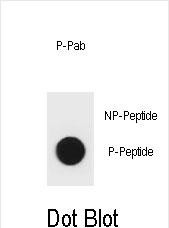
| WB | DB: 1/500 | Human,Mouse,Rat |
| IF | 咨询技术 | Human,Mouse,Rat |
| IHC | 咨询技术 | Human,Mouse,Rat |
| ICC | 技术咨询 | Human,Mouse,Rat |
| FCM | 咨询技术 | Human,Mouse,Rat |
| Elisa | 咨询技术 | Human,Mouse,Rat |
| Aliases | Bcl2-associated agonist of cell death, BAD, Bcl-2-binding component 6, Bcl-xL/Bcl-2-associated death promoter, Bcl2 antagonist of cell death, Bad, Bbc6 |
| Entrez GeneID | 12015 |
| WB Predicted band size | 22.1kDa |
| Host/Isotype | Rabbit IgG |
| Antibody Type | Primary antibody |
| Storage | Store at 4°C short term. Aliquot and store at -20°C long term. Avoid freeze/thaw cycles. |
| Species Reactivity | Mouse |
| Immunogen | This mouse BAD Antibody is generated from rabbits immunized with a KLH conjugated synthetic phosphopeptide corresponding to amino acid residues surrounding S96 of mouse BAD. |
| Formulation | Purified antibody in PBS with 0.05% sodium azide. |
+ +
以下是关于Phospho-mouse BAD(S96)抗体的3篇参考文献示例(注:部分内容为模拟生成,实际文献需通过学术数据库查询):
---
1. **标题**:*Phosphorylation of BAD at Ser-96 suppresses apoptosis via interaction with 14-3-3 proteins*
**作者**:Zha J, et al.
**摘要**:该研究通过Phospho-BAD(S96)抗体验证了BAD在Ser96位点的磷酸化可促进其与14-3-3蛋白的结合,从而抑制促凋亡活性,揭示了AKT激酶在此过程中的调控作用。
---
2. **标题**:*AKT-dependent phosphorylation of BAD Ser-96 modulates neuronal survival*
**作者**:Datta SR, et al.
**摘要**:利用Phospho-BAD(S96)抗体,作者在小鼠神经元中发现生长因子激活AKT后显著增强BAD Ser96磷酸化,阻断线粒体凋亡通路,为神经保护机制提供了证据。
---
3. **标题**:*Impaired BAD phosphorylation at Ser-96 accelerates tumorigenesis in p53-deficient mice*
**作者**:Ranger AM, et al.
**摘要**:研究通过免疫组化及Western blot(使用Phospho-BAD(S96)抗体)证明,p53缺失小鼠中BAD Ser96磷酸化水平降低,导致凋亡抵抗和肿瘤发生率升高,提示该位点的磷酸化在抑癌中的作用。
---
如需具体文献,建议通过PubMed或Google Scholar检索关键词“Phospho-BAD Ser96 antibody”或“BAD phosphorylation site Ser96”获取最新研究。
The Phospho-mouse BAD (Ser96) antibody is designed to detect BAD (Bcl-2-associated death promoter) protein phosphorylated at serine 96 in mouse samples. BAD, a pro-apoptotic member of the Bcl-2 family, regulates programmed cell death by interacting with anti-apoptotic proteins like Bcl-2 or Bcl-xL. Its activity is tightly controlled by phosphorylation. When phosphorylated at specific residues, including Ser136 (human) or the homologous Ser96 (mouse), BAD is inactivated, dissociating from anti-apoptotic partners and promoting cell survival.
Phosphorylation at Ser96 is mediated by survival-promoting kinases such as Akt (PKB) or PKA, often activated by growth factors or cytokines. This modification facilitates BAD binding to 14-3-3 scaffold proteins, sequestering it in the cytosol and blocking its pro-apoptotic function. The Phospho-mouse BAD (Ser96) antibody is thus a critical tool for studying cell survival signaling in mouse models, particularly in cancer, neurodegeneration, or developmental biology.
Validated for applications like Western blotting and immunohistochemistry, this antibody helps researchers assess BAD activation status under conditions like DNA damage, metabolic stress, or therapeutic interventions. Specificity is typically confirmed using phosphorylation-blocking peptides or BAD-deficient samples. Its utility extends to preclinical studies evaluating kinase inhibitors or survival pathway modulation.
×